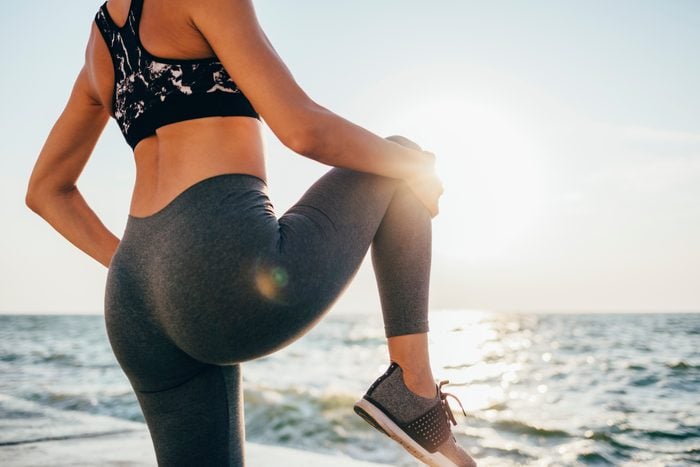
The best butt workout moves for your glutes
Step aside squats; there are plenty of other butt workouts that are better for isolating the glutes. Don’t get us wrong, squats aren’t an inherently bad exercise. They are excellent for your quads, the front thigh muscles of your legs, and your back muscles, too. Squats improve the overall strength of the lower body, and the movement also allows you to maintain tension in your glute muscles. (Your glutes are three muscles that make up your butt: the gluteus minimus, gluteus medius, and gluteus maximus.)
But the classic squat move might present a few challenges and shortcomings, especially if your goal is to work out your butt. For some people, squats put too much stress on the knees and back. And to get the most glute activation out of a squat, you need to know how to squat correctly. Your butt must be lower than parallel with the floor—a range of motion not everyone can achieve. Squats focus on going up and down. In everyday life, however, we also move side to side. So it’s important to target other muscles that are part of the glutes to move well.
Squats should just be one tool in your arsenal for glute growth. Here are the other tools or glute exercises that experts recommend implementing into your butt workouts.
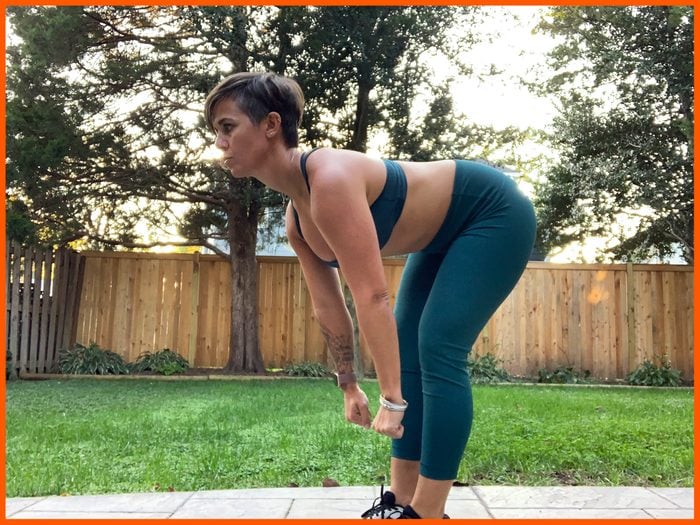
Bodyweight deadlifts
Five different strength training experts say deadlifts are one of the best butt exercises. Plus, there are tons of different variations of this movement. Kelly Vargo, a certified strength and conditioning specialist in Washington, D.C., and an instructor for the department of exercise and nutrition sciences at George Washington University, recommends a traditional deadlift. “This exercise is a home run for the posterior chain as it recruits the core, hamstring, and glute muscles,” Vargo says.
How to do a deadlift:
- Start this butt exercise in a neutral position standing with feet together, core engaged, shoulders relaxed, and a slight bend in the knees.
- The next step is to hinge at the hips and begin to bend forward. It is important to keep the shoulders back, almost retracted to counteract the tendency to round the shoulders forward, which is harmful to the back. Slowly continue to bend forward, keeping the hands close to the front of the legs and pushing the hips backward. There should be tension building in the hamstrings.
- Continue to bend forward until your shoulders start to round or until you get to the floor. Slowly extend the body and hips back into a neutral position.
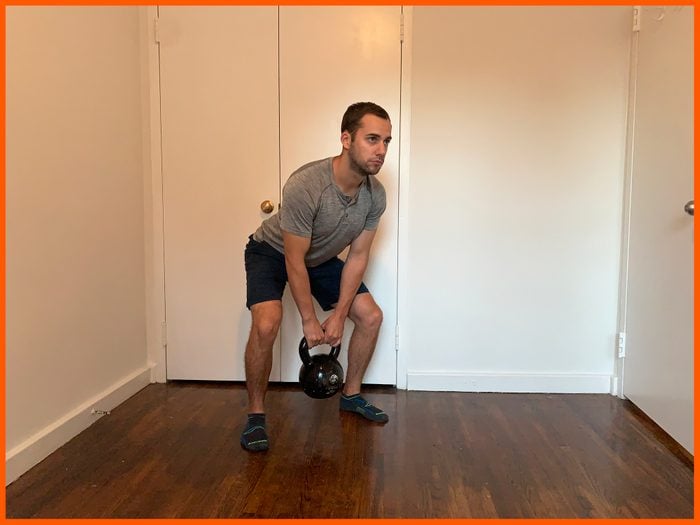
Kettlebell, dumbbell, or barbell deadlifts
For more challenging butt workouts, add some weight to your favorite moves. Although squats and deadlifts may look similar, they target different muscles, according to Henry Halse, a personal trainer with eight years of training experience in New York. “The deadlift involves your hips more because you’re lifting the weight off the ground and standing up with it,” Halse says. “The biggest hip muscles are your glutes.”
How to do a kettlebell, barbell, or dumbbell deadlift:
- Start with the weight on the ground between your feet. Stick your butt back and arch your lower back as you go down to grab it.
- Grab the weight with both hands and lift by driving through your heels.
- Then, stand up tall before lowering the weight back to the ground.
(Here’s a lower body workout to try if you only have 10 minutes.)
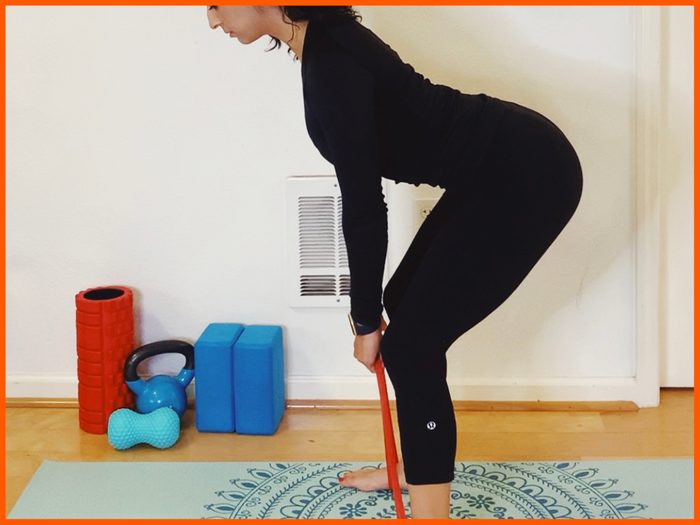
Bodyweight Romanian deadlifts
Leada Malek, board-certified sports physical therapist and certified strength and conditioning specialist in San Francisco, says that Romanian deadlifts bring in all the glutes and hamstrings to help protect your back and perform the movement well. If you work on your technique and activate your core, you’ll see awesome results with this movement. Make this movement easier by stopping halfway to parallel, Malek recommends.
How to do a Romanian deadlift:
- Stand with a slight bend in the knees and feet a comfortable hip-width apart.
- Push the hips backward and maintain a neutral or straight spine as you hinge down, stopping just before parallel with the ground.
- Keep the core engaged as you initiate from the glutes and extend the hips to stand back up.
(Change your exercise routine with these tips.)
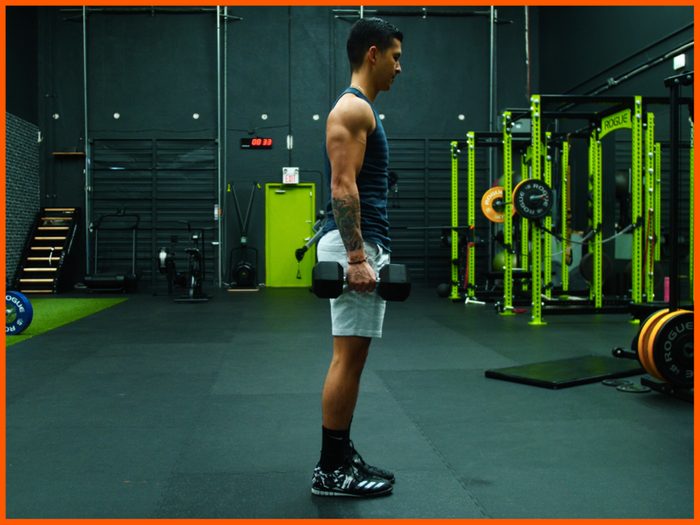
Dumbell or kettlebell Romanian deadlifts
Kettlebell or dumbbell Romanian deadlifts are a more hip-dominant exercise than the squat, according to Canadian-based Built With Science founder and kinesiologist Jeremy Ethier. That means the move favors the glutes more and enables you to apply more stress to the glutes in a slightly different way than other butt workout exercises. The movement provides an excellent glute stretch, too.
How to do a dumbbell Romanian deadlift:
- Hold a dumbbell in each hand by your sides. Brace your core by preparing as if someone were about to punch your gut.
- Next, hinge over at the hips by pushing your hips back like you’re “closing a car door with your butt” and lower the dumbbells. Keep your knees just slightly bent and your back flat as you come down.
- Once the dumbbells reach about shin level (or as low as you can while still keeping a flat back), squeeze your glutes and thrust your hips forward to stand straight up again.
(Here are the best exercises you should do at every age.)
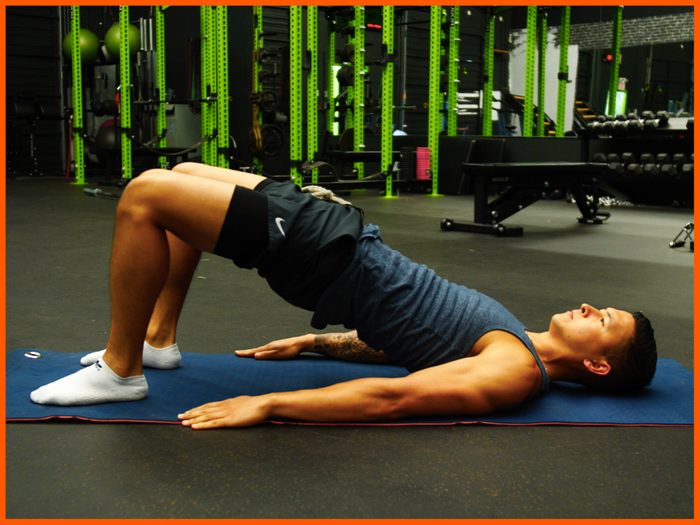
Glute bridges
Glute bridges are another popular butt move with exercise experts. Ethier likes them because a study in the International Journal of Sports Medicine found that they are more effective for glutes growth than the traditional squat. “It’s also a great alternative to squats for the glutes since it enables you to provide a ton of work onto the glutes in a manner that’s very easy on the knees and back,” Ethier says. You’ll see even more changes in your body if you’re lifting weights with this move.
How to do a glute bridge:
- First, lie on your back with your knees bent, and your core braced. Without arching your lower back, squeeze your butt muscles to get them engaged.
- Then, lift up while keeping your glutes contracted.
- At the top, squeeze your glutes as hard as possible for about 5 seconds before coming back down and repeating.
(Check out this celebrity-approved 10-minute butt workout.)
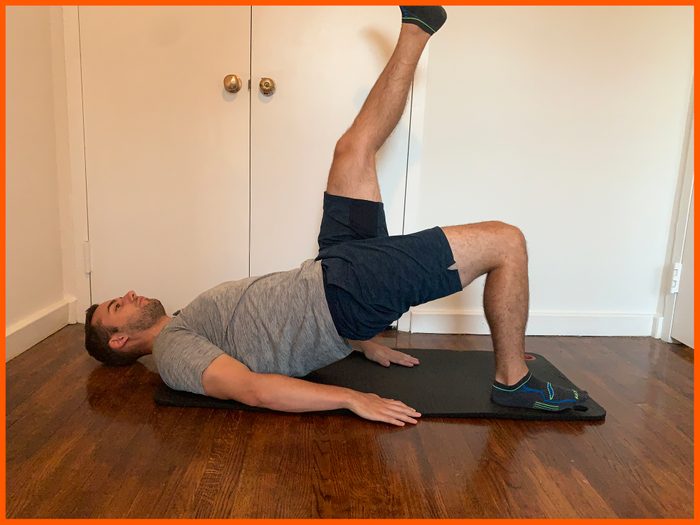
Single leg glute bridges
Take glute bridges to the next level and turn them into a glute isolate exercise by performing this move with one leg, Halse recommends. “Since you’re lying on the ground, you don’t have to concentrate on anything other than squeezing your butt,” he says. “Plus, you don’t need to get your quads and hamstrings involved.” Make it even tougher by holding a weight like a dumbbell in your lap.
How to do a single leg glute bridge:
- Lie on your back with both feet flat on the ground, 6 inches from your butt.
- Lift one leg straight into the air.
- Press through the heel of the foot that’s on the ground and lift your hips up as high as you can. That’s one rep.
(Don’t miss the best workouts for people who hate exercise.)
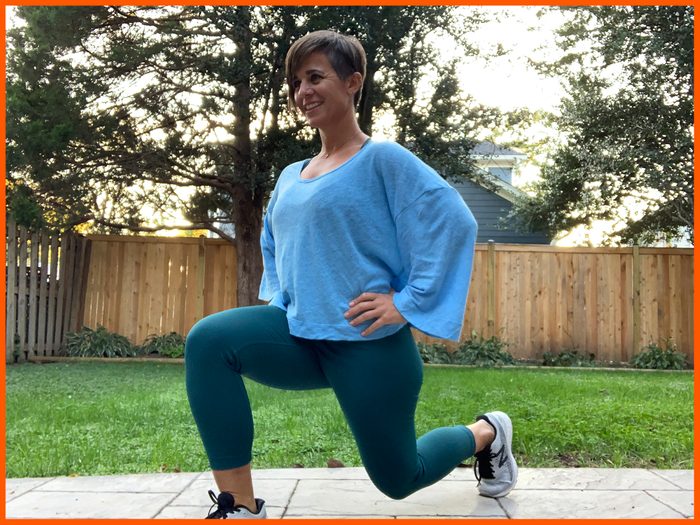
Lunges
Good butt workouts are incomplete without some form of a lunge. A secret from personal trainers: This move is transformative, which is just one reason to make it a staple in your glutes workouts. There are many different variations, but the traditional lunge is worth doing, according to Vargo. “Lunges fire up the legs, strengthen the core, promote balance, and recruit the glute muscles,” she says. “These exercises are a win-win for shaping legs and glutes.”
How to do a lunge:
- Start in a neutral position standing with feet together, core engaged, and shoulders relaxed.
- Step forward with the right foot.
- As the right foot lands on the ground, simultaneously bend both the right and left knees. Lower your center of gravity until your back left knee gently touches the ground. Ensure you are in an upright posture with the core engaged and shoulders relaxed.
- At this point, press off the floor with the right, front foot, raising the center of gravity and bringing the right foot back next to the left foot into the original starting position. Repeat with the left foot stepping forward.
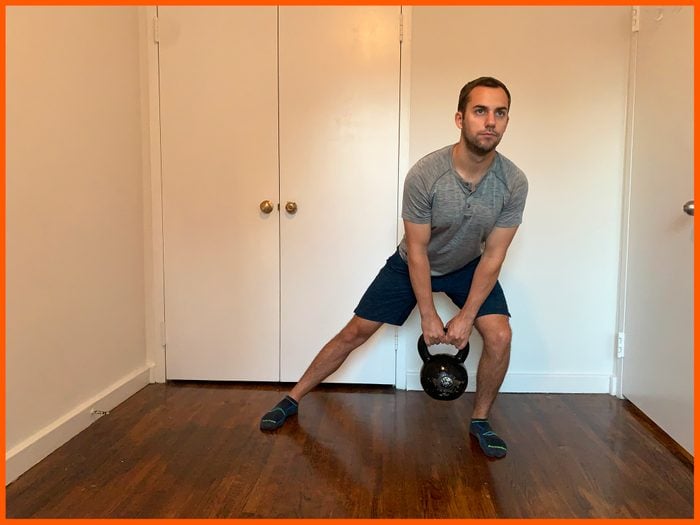
Lateral lunges
Always try to include a lateral movement in your butt workouts because the glutes are responsible for not only forward and back motions of the leg, but side to side motions, too, according to Halse. Not only is the lateral lunge his favorite exercise, but it’s also one of the quick workout moves that can transform your body.
How to do a lateral lunge:
- Hold a weight down in front of your legs with both hands.
- Step out to one side, stick your butt back, and reach the weight down towards the ground.
- Then, stand back up and step your feet together. Alternate legs on each rep.
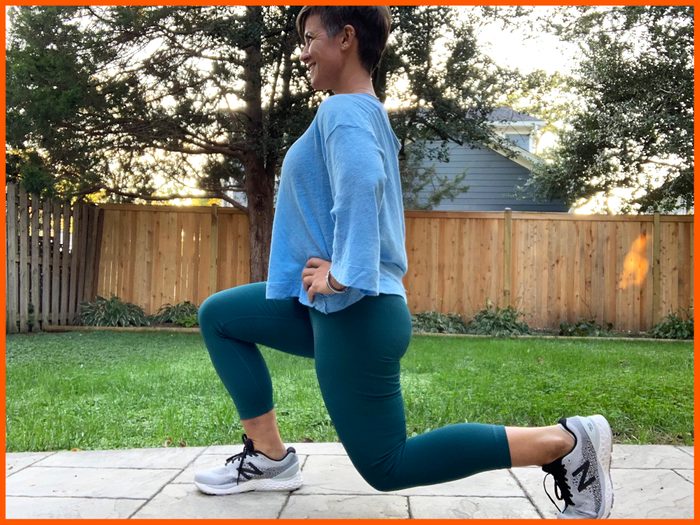
Reverse lunges
Hone in on your butt without putting tons of stress on the knees and lower back with this exercise that Ethier recommends. Plus, if you choose to squat, this is a great complimentary movement as it better activates the glutes and hamstrings, Ethier says. Make sure to focus on your form to avoid exercise injury.
How to do a reverse lunge:
- If you’d like, hold a pair of dumbbells at your side.
- Take a long step back and bring your back knee towards the ground until it just about touches the ground. Avoid rounding your back as you do so and keep your front shin vertical over your front foot.
- Then, push through the heel of your front foot to rise back up to the starting position. You should feel your glute of the front leg work as you do so. Repeat with the other leg.
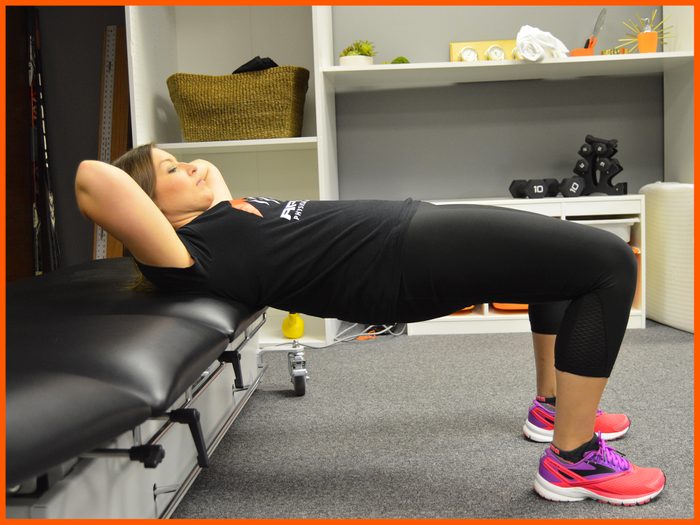
Hip thrusts
Morgan Rees, an LA-based ACE-certified personal trainer, and Lauren Lobert Frison, a certified strength and conditioning specialist, physical therapist, and owner of APEX Physical Therapy in Michigan, both suggest hip thrusts for good butt workouts. You can use a barbell, resistance band, or your body weight to perform the movement. You’ll need a bench or a chair about 12-18 inches off the ground, depending on your height.
How to do a hip thrust:
- You start with your butt on the ground, knees bent up, so your feet are flat on the floor, and leaning against a bench or chair. Line the bench up near the bottom of the shoulder blades.
- If you’re using a bar, place it along the hip’s crease. If you are using a glute resistance band, set it right above the knees.
- Keep your hands either behind your neck, in your lap, or resting on the ground, according to Frison.
- Keep your spine neutral, neck aligned with the spine (do not look down toward your feet), and press your glutes toward the ceiling lifting your butt off the floor, Rees says.
- You don’t want your back arched at all at the top. You want your lower leg to be vertical at the top, so you may need to adjust your feet to be closer or farther away from your butt.
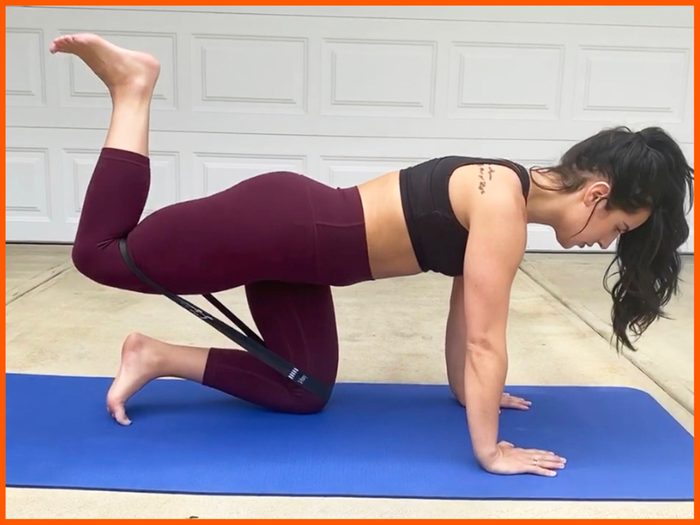
Kickbacks
Kick butt with your workout and perform this glute isolation exercise that Rees and Frison recommend for stronger cheeks.
How to do a glute kickback:
- This can be done with a cable machine using an ankle strap attachment, a band, or a dumbbell behind the knee. If you use a band, bodyweight, or weight behind the knee place yourself on all fours.
- Place your knees and arms shoulder-width apart, hands on the floor.
- Place the glute band above your knees or a dumbbell behind one of your knees.
- Press your foot towards the ceiling maintaining close to a 90-degree angle the entire time.
(This is how to keep your muscles strong and prevent muscle loss.)
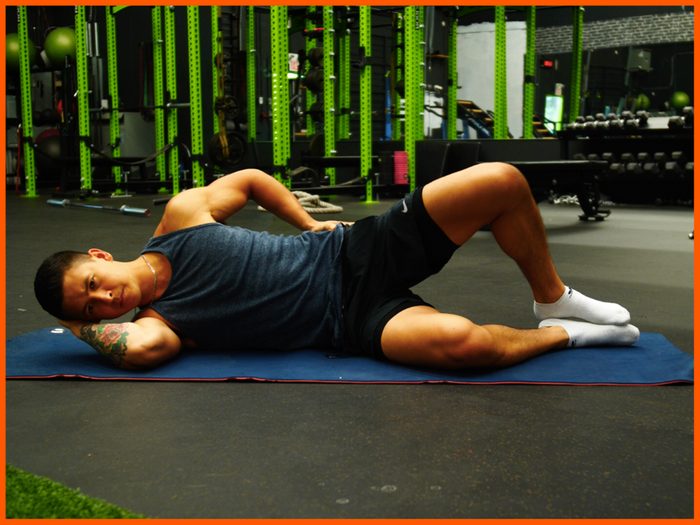
Clamshells
Ethier and Malek love clamshells to work your butt. “This exercise is important to target a glute muscle that tends to get overlooked in bigger movements like the squat,” Ethier explains. “It’s called the glute medius and plays an important role in hip stability and helping with the overall shape of your glutes as well,” Malek adds that this move is also good for the butt because it works hip abductors and hip external rotators. According to Malek, these are key balance muscles that help with knee stability so you can avoid injuries and knee pain during your butt workout and beyond.
How to do a clamshell:
- Lie on your side with your knees and hips bent. Use one arm to make a pillow for your head. With your other hand, place your thumb on the bone in the front of your hip. Wrap your other fingers around the upper part of your butt. This muscle is the glute medius, and you want to feel this muscle working as you do the following movement, Ethier says.
- Next, while keeping your feet together and core braced, open up your top knee like a clamshell so that the knee of your upper leg rises towards the ceiling. Maintain a bent knee level with the ankle. As you do so, avoid rotating your hips.
- Hold at the top briefly before coming down and repeating for more reps. If this move is too easy, add a resistance band around the top of the knees, Malek suggests.
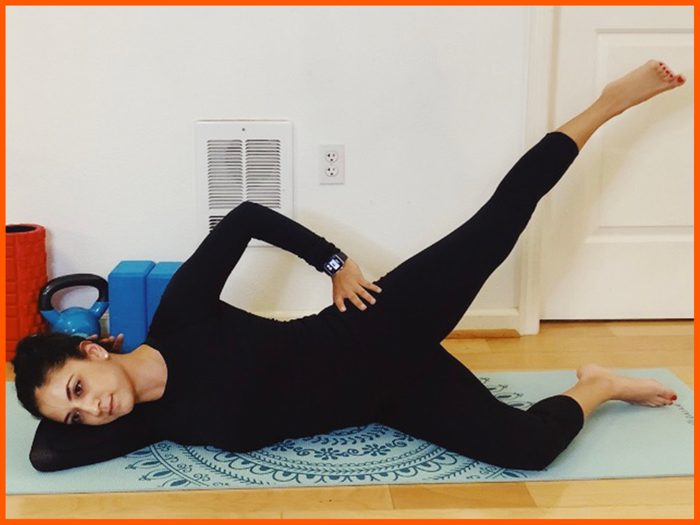
Side-lying hip abduction
Target the same critical butt muscle, the gluteus medius, with this movement. “This muscle is the balancing muscle in the glute group that helps keep us straight,” Malek explains. “It also plays a large role in controlling our trunk with hip hinges and bending over, which helps protect your back.” If this movement is too challenging, practice holding this at the top instead of doing repetitions.
(Abduction vs. adduction: knowing the difference will help you workout smarter.)
How to do a side-lying hip abduction:
- Lie on your side, legs stacked.
- Straighten the top leg, and lift it slightly behind the torso. Be sure to avoid rolling backward. Lower your leg, and repeat.
(Here’s an easy pull-up workout plan that will help you finally achieve one.)
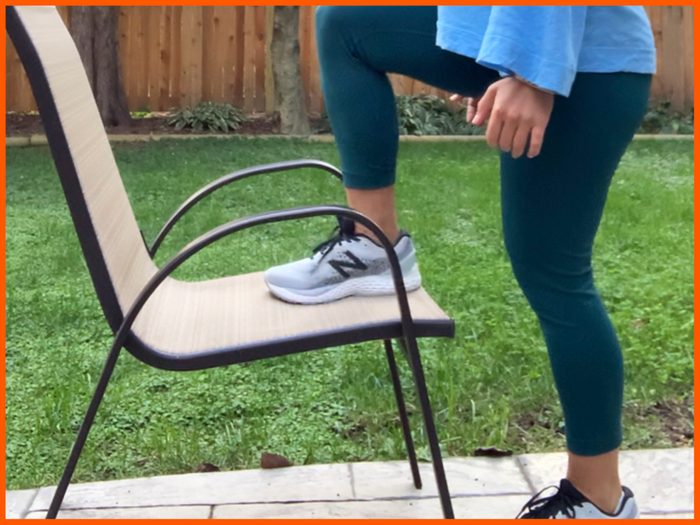
Step-ups
This glute exercise makes sure you’re working both sides of your butt. It requires stepping up and isolating the glute muscle of each leg, Vargo explains. If this move is hard to do with good form, strength training beginners can lower the step or chair’s elevation But if this is too easy, Vargo recommends adding in weights or increasing your pace.
How to do a step up:
- Start in a neutral position standing with feet together, core engaged, and shoulders relaxed. Step up with the right foot on the chair (or whatever tool for elevation you are using).
- Press down on the surface of the chair with the right foot, raising the center of gravity and bringing the left foot onto the surface of the chair.
- Step back off the surface of the chair with the left foot followed by the right foot, finishing the repetition in the beginning neutral stance. Repeat this with the left foot, Vargo says.
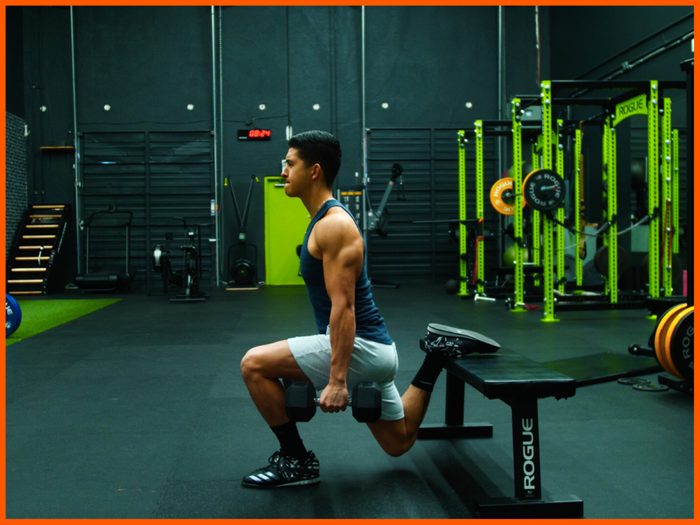
Split squat
The need to keep your balance during this movement makes it such a dynamic exercise for your lower body, especially your glutes. This is basically a single leg squat or stationary lunge, a good addition to your butt workouts.
How to do a split squat:
- Start in a standing position. Your back knee should be relatively perpendicular to the ground and can be elevated on a bench for support.
- Slightly hinge forward, keeping the front foot firmly placed on the ground. Keep your shoulders back as you hinge forward and lower yourself toward the ground and back up, according to Rees.
(Here are 7 balance exercises you can do every day.)
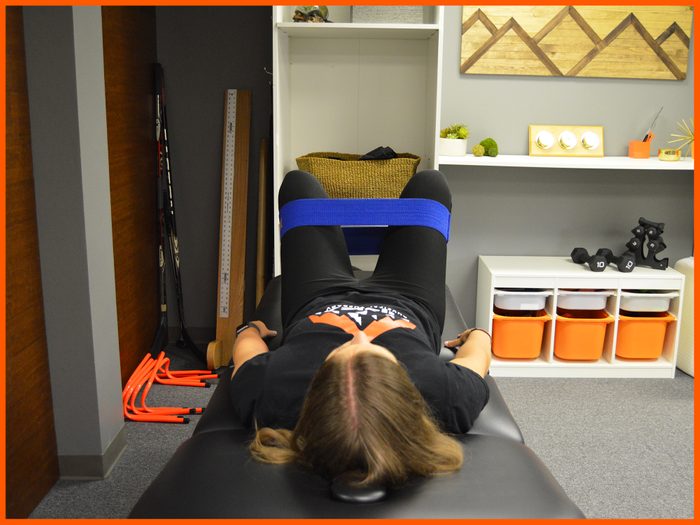
Hooklying hip abduction
Hip abduction occurs when you move the leg sideways and away from your body, Frison explains. The muscles used in this movement, hip abductors, not only involve your glutes, but they also help people perform basic everyday activities like walking.
How to do a hooklying hip abduction:
- Lying on your back with your knees bent, so your feet are flat on the floor, bring your knees apart and then back together.
- You will want a strong band around your legs, either just above or just below your knees. You can also do this sitting if you prefer, Lauren says. Don’t let the band snap your knees back together; control it on the way back.
(Here are some tricks to make walking for exercise even better.)
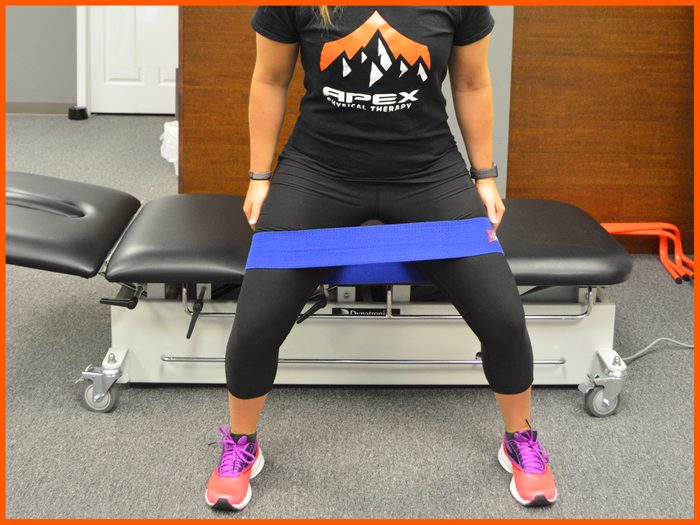
Sidestep
Target your glutes with this minimal-equipment move from Frison.
How to do a sidestep:
- Stand in an athletic position (slight knee bend, flat back) with and a resistance band around your legs (the higher up it is, the easier it will be so it can be anywhere from your upper thighs to around your feet). Take a large step sideways, keeping your toes pointed forward.
- Follow with the other foot, keeping tension on the band the whole time. Repeat, walking sideways, and then go back the other way.
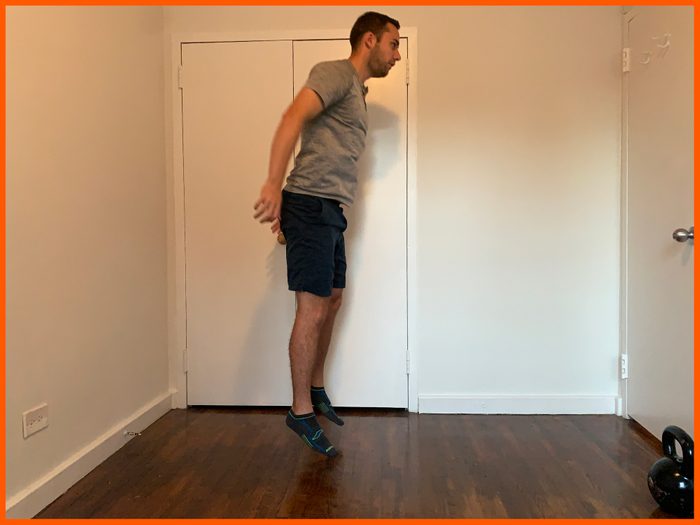
Bonus: Jump squat
OK, so this is technically a squat. But according to Halse, it’s worth adding to your butt workouts. “While regular squats aren’t as helpful for glute development, explosive exercises like the squat jump are,” Halse explains. “Your glutes are large and powerful, and designed to help you do explosive activities like sprint and jump.” That’s why you should try to include some jumping exercises in your workouts, like squat jumps. If you have knee, hip, or back issues, however, you might want to avoid this exercise.
How to do a squat jump:
- For this exercise, all you have to do is squat down low then jump up high. Try to get your feet to leave the ground. Land softly on your feet with your knees slightly bent and repeat, Halse says.
Next, check out the best thigh exercises to tone your legs.
